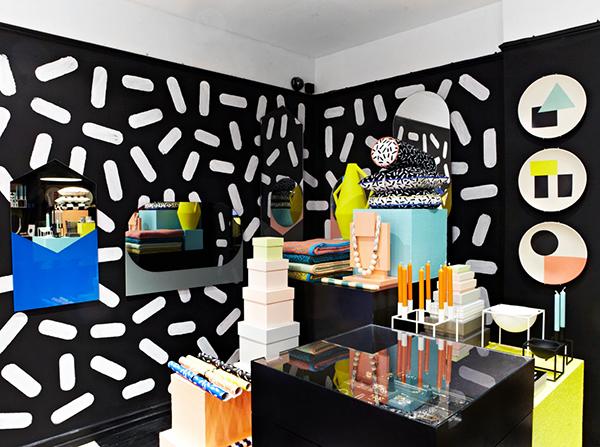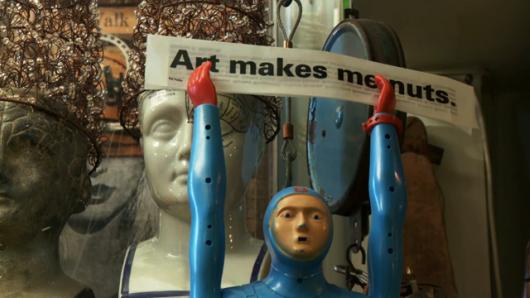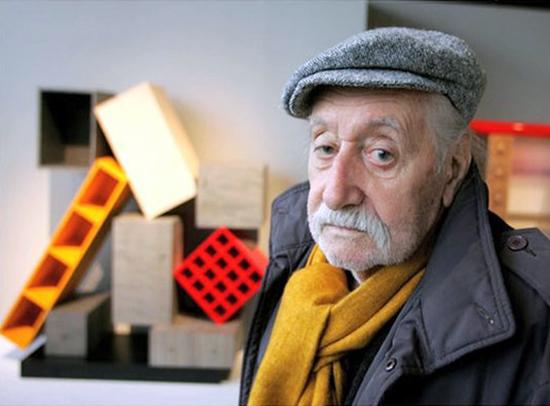
12.23.13
Excerpt: Magazine
Hans Ulrich Obrist’s Lost Interview with Ettore Sottsass, From Surface Magazine
It’s no secret that we’re devotees of the work of the late Italian design legend Ettore Sottsass, but to the extent that everyone we know has been caught up lately in the more superficial elements of his influence — the post-modernist colors, patterns, and geometries — we jumped at the chance to share with you this reminder of his intellectual legacy: one of several previously unpublished interviews with Sottsass conducted by Hans Ulrich Obrist in 2001. It was given to us as a little holiday present by Surface magazine’s new editor Spencer Bailey, who oversaw its inclusion in the Dec/Jan Art Issue, which was co-edited by ForYourArt founder Bettina Korek and is the fourth since Surface was redesigned and reimagined this past July.
Says Bailey: “Last fall, I was talking with Serpentine Gallery co-director Hans Ulrich Obrist over dinner in London about his unpublished interviews with artists and designers. He mentioned that he has several with Ettore Sottsass, so I asked him to send them to me. This one in particular blew me away. Hans Ulrich is a master interviewer, and Sottsass is, well, Sottsass. When I was putting together Surface’s first annual Art Issue, I just knew I had to publish it.” Sight Unseen is the only place on the web you can read the entire edited interview as it ran in the magazine — check it out below, including images added by us, and don’t forget to subscribe to Surface when you’re done!
Hans Ulrich Obrist: I’d like to begin this interview with the catalogue of your first exhibition, held in ’46, which you curated with Bruno Munari.
Ettore Sottsass: I was living in desperate straits in Milan, quite penniless, and we were working on so-called abstract or concrete art, as it used to be called then, with immense enthusiasm. People just didn’t want to know about it. Actually, I could be described as an outsider back then. I was a pupil of Luigi Spazzapan, a gestural painter who worked in a very graphic style. Just think — gestural painting already in ’38, ’39! Even my own abstract art was halfway between gesture and figurative representation. It wasn’t unrecognizable as such, but underlying it was a form of figuration. The abstract art of Munari or [graphic designer] Max Huber or Max Bill was by contrast a much more concrete form of abstraction, much more downright, more geometrical.
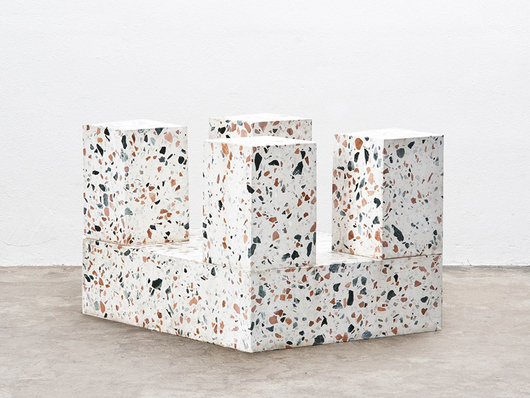 Concrete sculpture, 1985
Concrete sculpture, 1985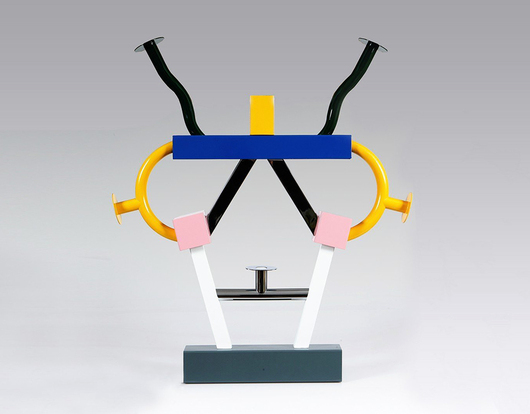 Ashoka lamp, 1981
Ashoka lamp, 1981
HUO: Let’s examine the importance of fluidity and circulation between separate disciplines.
ES: However you look at it, I feel the task of the designer or the architect is to design the artificial environment, from objects to architecture, spaces, and so on. Each design corresponds directly or indirectly to an idea one has of life, of society, of the relations between the individual and society. It corresponds to the form of the weltanschauung [or worldview]; it remains the basic cultural background. And this happens in whatever you do. Whether I design a vase or design architecture, there is always this background, this basic cultural background. The difference, then, is only technical. It’s clear that if I’m designing architecture, I need to know things that are not the same as what I have to know to design a glass vase, and to design a glass vase you need to know things that are not the same as what you need to take a photograph. But apart from these technical differences — which are certainly important because they have an effect on what I can design and condition — there still remains, deep down, what I think of life, why I do things, what I imagine happens when I design something. So I don’t see the point of any clear-cut distinction between disciplines.
Take the Renaissance. It was hardly an accident that the Renaissance was a period when many artists imagined, above all, a new kind of life. They imagined a new society, a new vision of the world, a new, say, interpretation of the potential of life. They didn’t make a major distinction between Brunelleschi’s dome and the design of, say, some other work of architecture. They tackled the technical differences that might influence the way they used these different vocabularies, but nothing more.
HUO: Whenever your writings are published, there are always lots of questions, discussions that cause upheavals in artistic circles. And this happens not just here in Italy but also abroad among younger architects, with debates over what you assert fearlessly. Your position is immensely relevant because you speak rather critically about the world of highly specialized architecture. You have defined a much more transversal approach in practice, and for this very reason, perhaps, you also interest young architects today.
ES: The important thing is to think about what’s happening. For example, I come from the mountains. I was born in Innsbruck, Austria. I spent my childhood surrounded by woods, mountains, high crags. I have a sense of weight that’s quite different from Norman Foster’s, though I have no idea where he was born — at any rate, he has an idea of weight quite different from mine. Weight riles him, but it comforts me. If a thing is heavy, I feel laid back about it. If it’s flying through the air, then I start to worry. So there are these different strands in our visions of the planet, of the cosmos, and the feeling we have, right from the start, about these things.
HUO: I find nowadays that it’s really interesting to try to grasp our relationship to certain developments in science. It’s interesting that scientific progress began a big debate about uncertainty.
ES: About unreality.
HUO: They talk about uncertainty. This is the doubt.
ES: It’s a doubt that’s developed in my own mind. But I think I’m not the only one to feel this. I believe it’s valid for scientists, too. A few years ago, I began to have some sense of the scale of the cosmos. I told myself our planet is in the solar system, which belongs to a galaxy, and in this galaxy there are hundreds of thousands, perhaps millions, of solar systems, and there are several billion galaxies. Well, at this point I said to myself: I can’t understand what all this means. Even the fact that we could see the earth from the moon or from the sky stunned me. It confirmed the fact that this planet is a paltry orb spinning in a void. From one minute to the next it could blow up or collide with something, or just die slowly of cold, or whatever. I feel that in olden times the whole effort consisted in trying to reach some point, to identify reality; today, it’s just the opposite. Today, we can’t get a grasp on anything.
Existence is fragmentary, because we no longer accept the logic that we hoped would tie up everything. Even that great scientist strapped to a wheelchair, Hawking, said this: “If we could find a formula that holds together the universe, I’d know what to think of God.” The fact remains that this formula can’t be found! It doesn’t exist!
At any rate, the same problem exists in everyday life. When I read a newspaper, for example, I can’t grasp the dimensions of what’s happening between here and, say, the Middle East, between here and New York.
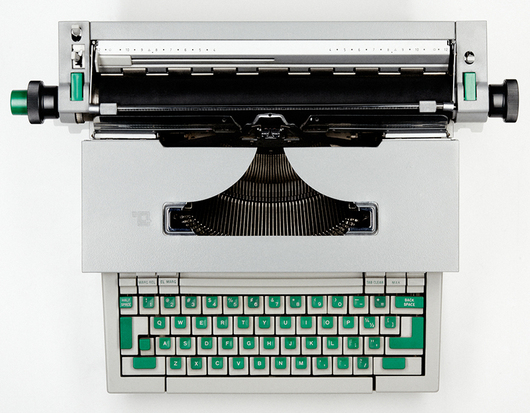 Praxis 48 typewriter for Olivetti
Praxis 48 typewriter for Olivetti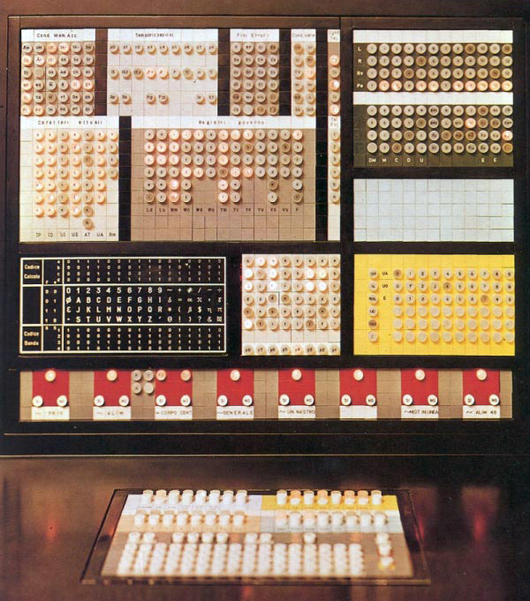 Elea 9003 computer interface for Olivetti
Elea 9003 computer interface for Olivetti
HUO: As for science, I asked myself a lot of questions quite recently, after reading a book by a famous cyber expert who worked in the ’50s for Olivetti. You, too, since the ’50s have worked in that field, and I wondered if you had any contact with scientists.
ES: No, but when I worked at Olivetti on electronics, it was back in 1959 or 1960.
HUO: When you were working on that first big computer [the Elea 9003]?
ES: Yes, a huge computer. It was in Pisa; I arrived by train. Then I had to get a horse-drawn carriage, because there were no taxis, and it took me to the outskirts of Pisa, where there was a 19th-century villa surrounded by a garden. Inside there were all these white-coated engineers walking among miles and miles of cables snaking across the floor. Even electronics in those days was a bomb of uncertainty. It still worked with valves, valves of colossal dimensions. Now, not so many years later, we all have nice little packets of electronics in our pockets.
HUO: You were one of the first to speak about a planetary and global influence. Many of your writings were very advanced in this respect; their topicality seems very significant. There is a presentiment even in the use you make of the terms “planetary” or “global” that is really worth exploring, given the dimensions they have achieved today. On the one hand, all your work is research into archetypes, or rather into global elements, while on the other, you also study—you explore—the local in great depth. This presents us with a paradox, a fertile contradiction, don’t you feel?
ES: I feel very deeply — even if one is an atheist, even if he doesn’t seek the truth — that we are all compelled, conditioned, to act out a comedy. We’re doing it here, too, at this moment. You ring me, you arrive, we do these things. At this moment, the comedy is reduced to these actors: you, me, and our photographer friend. You know there’s this humdrum routine, and there’s also this, say, humanity. What would be interesting, or at least I’d find it interesting, would be to understand, or try to understand, what the essence of this humanity is. Not its relationship with the cosmos, but its inner essence. Why we are men, what we are doing as men, what responsibilities we have as individuals with respect to society, and so forth. I find this is the most fascinating part of thinking at the current time. Heidegger already had this fixation with trying to understand the human essence. Why do we think? Why do we have these relationships? How far can we develop this line of argument, this comedy? How can we control this comedy or at least know something about it? If you did an exhibition in a kitchen, for example, that would interest me greatly. To me, it’s like saying: “Okay, we’ve got to eat, we talk about eating, and we feel we’re intellectuals in this place, a place where you eat.”
HUO: About your research into kitchens—I read a really interesting article dating from ’92. When did you start working on this topic?
ES: I can’t really say. I think some time in the ’60s.
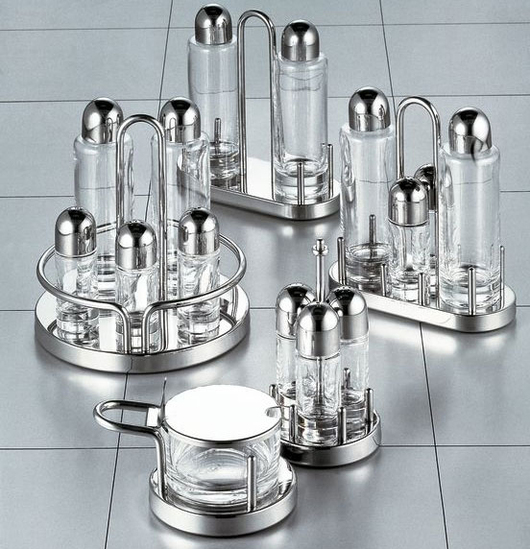 Condiment sets for Alessi, 1978
Condiment sets for Alessi, 1978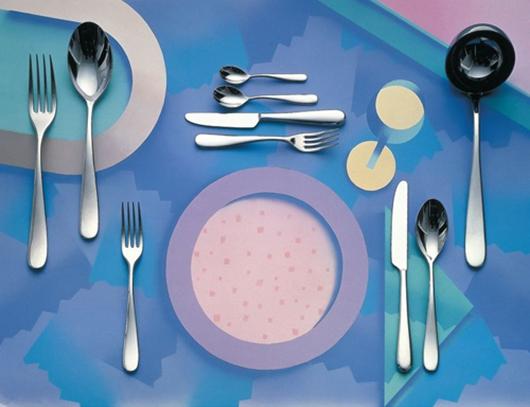 Nuovo Milano cutlery for Alessi,
Nuovo Milano cutlery for Alessi,
HUO: There are a lot of photos you took of kitchens.
ES: Yes, there are a lot, partly because first I was married to a lady by the name of Fernanda Pivano, a writer well known in Italy for translating and writing about contemporary American literature, and she couldn’t even make a cup of tea. For reasons I won’t go into now, we split up, and I met another young lady, Barbara Radice, and she has a lot to say about cooking — how it’s done. She talks a lot about it, not fervently, but almost as if it were a sacred ritual. For example, the other day she asked the chef at the Torre di Pisa how many minutes a certain kind of pasta had to cook. The chef, a woman, said, “Minutes? I just look at the pasta.” Meaning she didn’t need mathematics, or to measure time, but a visual, sensuous contact with the pasta to know if it was cooked or not. She needed years of experience.
HUO: I read your texts on kitchens by chance, as well as your other books, during a period not far from when I first began to take an interest in the work of Italo Calvino. I often wondered whether or not there was a connection between you two.
ES: No, I knew him, but only casually. We never went beyond wishing each other good evening, and we never worked together. But as for what you’re saying, in ’56 I went to America for the first time, and I met George Nelson. We Europeans — I don’t know if we can say “we Europeans” — but we who belong to these cultures on this side of the Atlantic, we have death in our pockets. We can never forget this destiny. When I used to talk with George about death, he said, “We Americans never talk about death.” There’s an architect from San Diego who’s been working with me for years, Johanna Grawunder, and whenever she sees something even indirectly connected with death, she says, “That’s very strong.” Why is this? By contrast, in India, I found it very consoling. When you look out the hotel window every half-hour, you see a corpse being carried off, wrapped in a shroud and strewn with flowers. This ability to relate to this inexplicable phenomenon is consoling.
HUO: So you think the architect ought to make these things visible in his work? Or other things that are more important to you?
ES: It’s no use asking me this because by now I think there’s nothing to be done. This is because we now live in an industrial culture. We invented the machine a few centuries back, and I feel the machine fulfills its own destiny just as bronze, say, meant a new way of waging war, of killing. The fact that a lot of products can be mass-produced with machinery, resulting in masses of products, inevitably means that we have to sell these products; we have to give them to someone, and selling them inevitably entails all the possible forms of persuasion so people will buy them. The upshot is that we think less and less because we’re increasingly conditioned. For all these reasons we can no longer say, “I wish the world was like this or like that.” The point, if there is one, is to find a way to navigate our way through this destiny.
HUO: How do you think we can reverse this process?
ES: I don’t see a way. Anyway, I’m not someone who wants to change the world.
HUO: How do you view the city? Say, Milan, or the city in general, the planning issues involved?
ES: The city is jam-packed with cars. In Milan, you can hardly move, and we all keep saying: “Hell! It’s full of cars, how can we keep going in a city like this?” But as long as Fiat or Mercedes keep on turning out 2,000 automobiles a day, they’ve got to go somewhere! And if we tell Fiat to quit making cars, there’ll be thousands of people out of work. I feel this kind of impossibility, this thing I call destiny, something inevitable.
HUO: It’s also interesting to see what’s happening in Asia. There are a lot of Westerners, planners, who tell the politicians, “You’ve got to prevent the kind of problems we already have from taking root here.”
ES: That’s inevitable. It would be like telling someone who lives by the sea not to go out in a boat, not to go fishing, or someone who falls in the water and can’t swim not to drown. True, there’s a life jacket, but that’s not the solution. That’s why we increasingly talk about humdrum, everyday things, about private peace and quiet.
HUO: About a micro-utopia.
ES: Yes, I think so. Andrea Branzi sent me a text where he says that we can only work on the micro-situations. That’s why I think the Dalai Lama enjoys a certain success. [Laughs] It’s got nothing to do with it, really, but classical Buddhism, not the institutional kind, had this idea of working on our micro-existence, on micro-gestures, micro-events.
HUO: In connection with what you’re saying, there’s also a text from 1988 devoted to houses, in which you describe these micro-entities that appear in every culture.
ES: Which of my texts was that?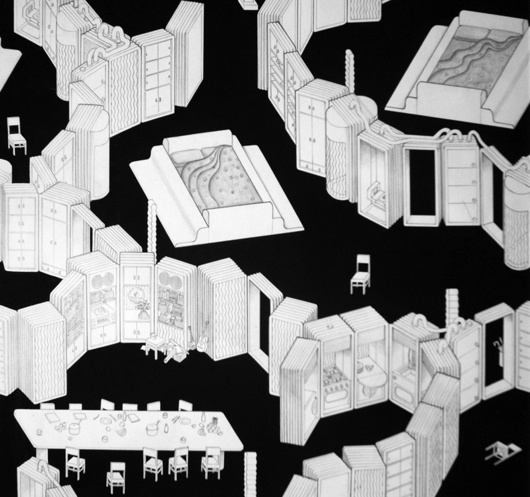 Mobile and Flexible Environment Module, 1972
Mobile and Flexible Environment Module, 1972
HUO: The one in which you describe places you visited and the impression you got of them. Your description, which is very precise, shows there’s always someone who has developed houses by adapting to the given conditions, just as mushrooms adapt to a forest.
ES: It’s a situation that becomes clear if you travel. For instance, in Myanmar you see houses that clearly correspond to a definite world. At the same time, the environment determines the way the house is built. If there’s a stream and the women have to fetch water, then the house is built near the stream. I could give plenty of other examples. In mountain areas, the houses are made of stone; in deserts, of hangings. All of us carry around our own cultural symbols. There are peasant houses where they hang a sheaf of corn over the door for good luck. Then there are bank buildings that have massive doors that overawe you, so when you go and ask them for money, they make you feel: “Watch out! You’re coming in here, and we’re going to make mincemeat out of you!”
HUO: How do you see the question of housing in the city?
ES: As long as humanity goes on growing at the rate we’re growing now, the distance between one person and another is going to grow bigger, like the distance between one place and another. So this idea that we can go from house to house on foot as one did in the Middle Ages, or the idea of the piazza—they just get lost. People living in a group of houses all gathering in a kind of outdoor salon or piazza—that’s simply unattainable nowadays. In Milan, I only ever visit one or two districts, that’s all. All of us living in big cities just really live in one or two districts.
HUO: But what about the subway system?
ES: True, but if one of the young women who works in my office says she has to leave home at 7 a.m. because she has to be here at 8, I instinctively feel, “Poor thing!” In New York, it’s even worse, because you have a two-hour train ride every morning and two hours every evening to get home. You get home and your house stands in the middle of a garden, but it’s no use, because when you get home you have to hit the whiskey to get over the traveling, and that’s no solution either. We all know about American and English garden cities, but you get home so shattered from hours of commuting that you no longer feel the house belongs to you. You ask me what I think about the problems of the city, but I don’t know what to answer. I’ve often asked myself how I would conceive a big city. We worked on a master plan in Korea, a project for the layout of an urban area around Seoul’s big international airport, one of the biggest in Asia. There’s a lot of competition in airports, between Japan, Korea, China.
HUO: Because they’ll soon be having the World Cup.
ES: Perhaps, but at present there’s also competition for business. To build this airport [in Korea], they filled in the sea between two islands. For 10 years they’d been unloading soil between one island and another, and they asked us to put forward some ideas for a master plan. The project grew out of this. We asked ourselves: “What should we do in a place like this?” The only thing we could think of was to lay out some big express roads running through the center of the city and some other minor roads—first semi-private and then private—that became increasingly convenient for people to use, easier for children, for women. We laid out big pedestrian precincts linked by express roads. This is not such an unusual concept after all; it was one of Le Corbusier’s ideas. We also thought—but I guess this was an ideological utopia—we could create a city without ghettos, to avoid having a working-class zone, a middle-class zone, and a zone for the rich. We thought that these different zones should overlap. But I repeat: I don’t know whether this can really be achieved. Anyway, we proposed a form of zoning to prevent what happened in Beverly Hills, where there are big chic areas with peaceful streets and then huge tenement blocks in the outer city. I feel we have to think a bit more carefully about these situations. In short, planning is a makeshift science!
HUO: In a text of yours I read, you describe an imaginary journey through your drawings, and you speak of an archive. I’d really like to see this place. The text also speaks of a cupboard as a mysterious, scented place.
ES: Yes, I once wrote about this cupboard where I keep all the paints, the papers, my instruments for drawing, and whenever it’s opened, it gives off a wonderful perfume.
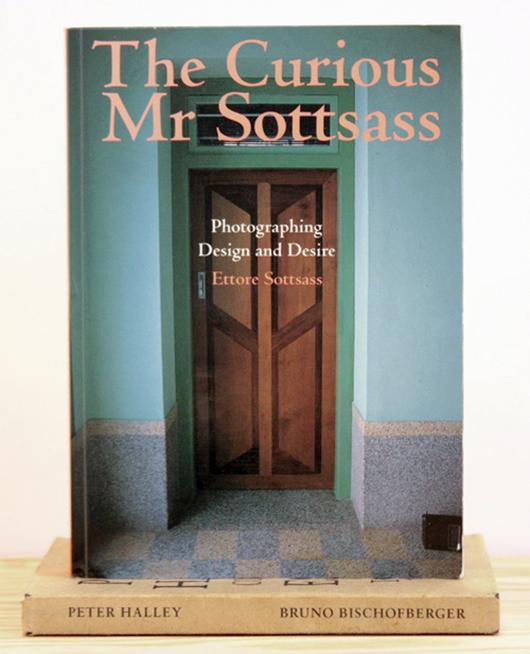 The Curious Mr. Sottsass, available at Karma books
The Curious Mr. Sottsass, available at Karma books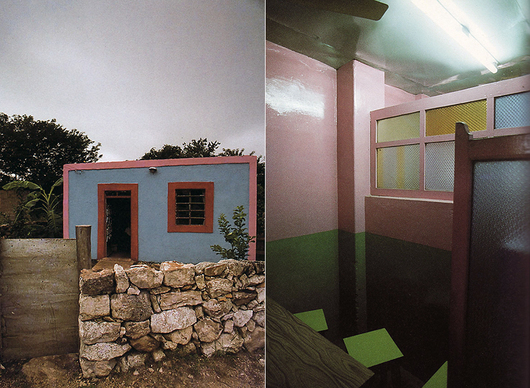 Photos from The Curious Mr. Sottsass
Photos from The Curious Mr. Sottsass
HUO: What about the archive?
ES: Some time ago I published a book of photos with an English publisher, Thames & Hudson, titled The Curious Mr. Sottsass. There’s also an edition in French. For the occasion of its release, about five years ago, I began to organize my photo archive better. I’ve almost finished.
HUO: What’s the importance behind this concept of traveling?
ES: Well, curiosity. There’s an almost paranoid form of curiosity to see what’s on the other side of the fence and also the urge to see if some things are confirmed or not confirmed by it. But actually I believe you travel to confirm your ideas, and whatever you can’t confirm you discard as you travel. In a certain sense, you redesign yourself when you’re traveling. But then there was a moment when I felt the need to get away from Italian provincialism, even European provincialism.
HUO: During these trips, did you meet any artists and intellectuals?
ES: Sometimes I did, sometimes not. I went to Japan a number of times and always met architects. On one of my trips to India, I stayed with [painter] Francesco Clemente at his place for a month, and I learned a lot there: for instance, this idea of accepting the corruption of things, the destruction of things, as destiny. I learned that in India, because the people there don’t care in the least if things wear out. They have a much more tenuous idea of life. Life wears out, you grow old and wear out, marble wears out, roads change and this is a concept Western culture tries to avoid. We repaint the house, we keep things repaired—everything has to look new all the time, everything has to be under control. That kind of suppleness the Indians have, the fact that problems of this kind don’t exist for them, strikes me as wonderful. All this is very obvious in Francesco, who is not just a painter but a thinker. At any rate he paints amid this permanent uncertainty, awaiting this destruction.
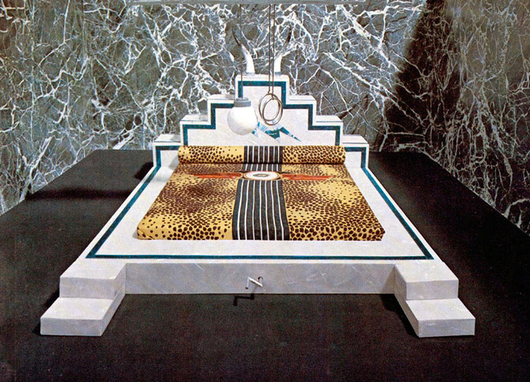 One of Archizoom’s Dream Beds, 1967
One of Archizoom’s Dream Beds, 1967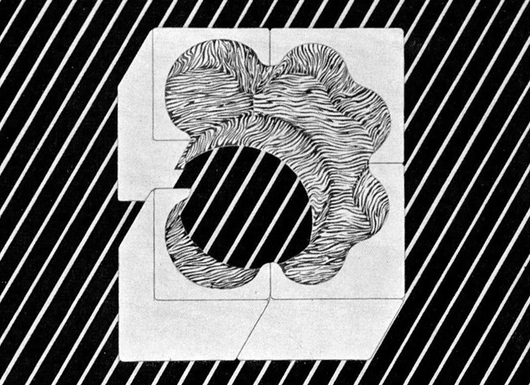 Drawing for Archizoom’s Safari sofa, 1968
Drawing for Archizoom’s Safari sofa, 1968
HUO: Can we go back to the question I asked you earlier, about your interest in other disciplines, the interdisciplinary approach so obvious in your work? One thing that comes out in your texts is the experience—or rather, the attempt—to found the Global Tools design school.
ES: It’s not that I founded it. I was part of the Archizoom Group with Andrea Branzi, plus some other people, especially some young Florentines. In Florence in the late ’60s and early ’70s, there were some very aggressive groups that came from the political protests of ’68, and we were all beginning to question our role. We asked ourselves about the professional position of designers in relation to industry. It was a period when I was hardly working any more. I no longer worked as a designer. I only worked for Olivetti because it was a rather special company. But it was there that I first refused to see myself as an industrial designer in the classic sense of the word.
HUO: Meaning opposition.
ES: Yes. In this context, we founded Global Tools, which lasted just a few months because the more extremist youngsters tried to destroy any intellectual operation. It was the period of the Cultural Revolution in China, and they were dismissive of everything. This experience of ours didn’t last long. The idea was to retrieve elements that had disappeared from design or had never been part of it.
HUO: Did you try to redesign some social aspects of the design profession?
ES: In a sense, yes. We hoped to have a gallery we could use to hold exhibitions, to present our work together, without too many constraints. In the end, we found a gallery, but the gallery owner happened to be a big steelmaker, so those extremists objected, “We can’t work in this gallery because we’ll be conned by the steelmaking capitalist.”
HUO: In Global Tools, there always appeared this sense of resistance to priorities, to the exaggerated importance of the visual sense in our culture.
ES: More than the visual sense, it was resistance to the priority and the predominance of the intellect over the senses. The whole of Functionalism, as the word itself shows, was a hope that the intellect would succeed in controlling design all the way through. Instead—and this was the novelty—we found confirmation of our ideas in India and many other places. What I think is that, first of all, we read the world sensuously. We also catalogue it and intellectualize it, but the source of everything remains the senses. To a Functionalist, the surface of this table is a geometrical square; to me, it’s a piece of plastic, warm or cold.
HUO: So Global Tools was also a revolt against Functionalism?
ES: Not against it. We tried to go beyond it. We were never against anyone. I come from the Functionalist school—Gropius, Le Corbusier. When I was young, they were my myths, and I’ve never forgotten them, I’ve never despised them. But I’ve always thought all this wasn’t enough, that we could go much further. To those generations, the word “functional” meant ergonomics more than anything else: the relation between the human body and physical space, a relationship based on measurement. But to me, functionality often involves issues that can’t be measured.
HUO: Having begun with a question about your first exhibition, I’d like to finish with a question about exhibitions and museums. The point you mentioned is fairly traumatic: the overriding need to bring back all the senses to museums, because they are totally excluded.
ES: Yes. I think, for instance, that a museum of design is out of the question. It just can’t be done. An object has a value because we can touch it and use it. Even a museum of architecture is almost out of the question in terms of my idea of architecture. Architecture is a space where you can walk: You pass through it, you touch it, you see the light. I really believe a museum of applied design done like the few I’ve seen is pointless. They generally take a razor and put it on a pedestal. But a razor isn’t a sculpture, it’s a razor. Even a chair is a chair, and you have to sit on it. So there’s a big difficulty in doing a design museum.
The same is true with a contemporary art museum. Conceptual art comes out strangely in a museum. You go there and see a white room with a line and you say, “Heck, is that meant to be strange?” At times, I think museums ought to be enormous, underground, gigantic archives, with the part the public visits just putting on temporary exhibitions that closely reflect what is happening outside, historical changes, etc.
HUO: So, underground, there’d be an infinite archive, and above, changing appearances?
ES: Each person would visit the museum a number of times because every exhibition would be different. I don’t think there’s much interest in museums conceived the way they are now, as museums of institutional representation.
Excerpted from the Dec/Jan issue of Surface magazine and reprinted with special permission from Hans Ulrich Obrist and Surface. Click here to become a Surface subscriber!
